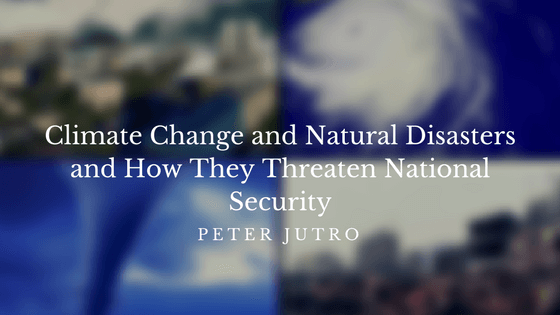With the recent landfalls of Harvey, Irma, Jose, and Maria this hurricane season, the conversation about our preparedness for disasters such these arises yet again. The new variant on the topic is how climate change can threatening our national security. If we take a look at some of the factors surrounding this issue, we see that low-lying coastal cities are struggling with aging infrastructure, have the largest populations, and are at the highest risk for disastrous flooding. Natural disasters affect citizens in the US more frequently than terrorism, but until this year, the latter got more attention, and terrorism still gets disproportionately more of its needed funding than do disaster preparation and response. It’s time that we as a nation recognize that how we respond to these natural disasters may be a true indicator of our national security and if so, that we should prioritize it as a national security issue.
I admire my former colleague, Dr. Sherri Goodman, who has been working diligently for many years to clarify these issues for both the Department of Defense and the American public. In a recent commentary for CNBC, she expounded on how the damages caused by those recent storms revealed our lack of preparation for extreme weather events. On top of that, the destruction that occurred in Houston demonstrated that the issue of climate change is becoming a direct threat to the security of the people here in the US. Preparedness is a big issue on this front. In the wake of Hurricane Harvey, emergency management officials in Texas have acknowledged that they were unprepared for the severity of the storm, and many have come to recognize that it was likely made much more severe as a result of climate change. Scientists have been explaining how warmer air and rising sea levels are causing hurricanes like Harvey to become more dangerous. Unfortunately, we still have elected officials who deny the possibility of a relationship between climate change and these disasters; they fail to recognize the relationship between warming ocean and atmospheric temperatures, and the intensifying strength and severity of storms. As a result, we continue as a nation to be insufficiently prepared, and thus, our citizens remain more vulnerable.
We do however have military leaders and civilian planners who recognize that storm extremes are becoming more frequent as the climate warms. The problem remains that we haven’t yet taken the steps necessary to be prepared for these events when they do occur. It seems that natural disasters are becoming the most prevalent threat faced by the government, the private sectors, and the nation’s citizenry.
Interestingly, the military often thought of as fixed in its traditional ways, has been in the forefront of preparing for these concerns. They look at their operating environments, their readiness, the types of missions they undertake, and the role that the US and its assets play in addressing threats both in the US and abroad. They have recognized there are a substantial and growing number of US military facilities being impacted by rising sea levels; perhaps the largest facilities at greatest risk are the naval bases in Norfolk and San Diego. Fortunately, the military is being proactive in approaching these problems.
Similar problems also face state and local governments, law enforcement officials, and emergency responders, and engineering studies, as well as our own observations, have made it clear that our current infrastructure is outdated and inadequate. One must hope that these recent disasters will serve as a prod to officials to invest more realistically in order to save lives, defend the nation, protect property, and in the long run, to save money.

